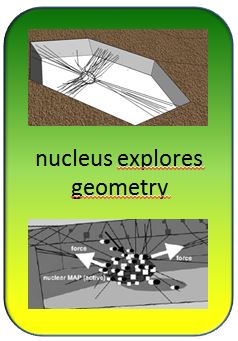2015_04 How the nucleus explores space
What is the topic?
Plant shape is coined by a "direction" of individual cells. Similar to elementary magnets, plant cells can orient themselves by means of their dynamic cytoskeleton as "compass needle" with respect to signals from their environment. We have developed an experimental system that allows to observe this process of "direction-making". Hereby, we observed that as first step the nucleus has to locate the center of the cell. Then, from this cell center first the actin cytoskeleton ("the muscles of plant cells") is organised and defines the tip of a virtual arrow. Perpendicular with this arrow microtubules align and generate a parallel orientation of the cellulose in the cell wall. This cellulose texture will then reinforce growth of the expanding cell in a longitudinal axis. But how does the nucleus "know", where the cell center is? There is no metaphysical observer telling the nucleus, how the cell looks like as an entity. We know meanwhile that the nucleus is tethered on actin and microtubules and moves by means of plant-specific so called KCH motors. Actin is flexible and can confer traction forces, microtubules are stiff and can confer compression forces. The coupling of both elements by the KCH-motors generates a so called tensegrity, a principle widely used in modern architecture: rods are connected by elastic threads and allow great stability at minimal use of material. The advantage of such tensegral systems is the emergence of a mechanic entity and wholeness - mechanic forces can be sensed over the entire cell as entity. We want to test in this project the idea that the nucleus, by means of the tensegral cytoskeleton can sense its position in space and wanders in a searching movement till it has found the point of minimal tension - which is the cell center. The cytoskeleton has been traditionally perceived as lattice that maintains cellular structure - our project creates a new viewpoint: the plant cytoskeleton is probably more something like a sensory organ that allows the cell to perceive and to adjust geometry, in a manner that is analogous to the way, how human beings generate a representation of their own body by perceiving the tension of our muscles.
Project
DFG-Project NI 324/20-1: How plants measure symmetry: nuclear positioning in plant cells, 2 years postdoc position plus 30 T€ consumables.

